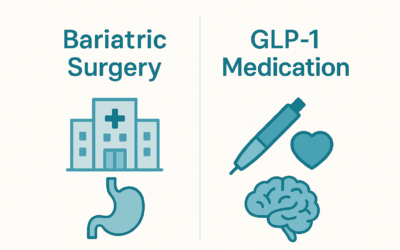Why the name on the label costs so much
Not all weight-loss medications are created equal — but sometimes, they’re created exactly the same. That’s the case with tirzepatide vs. Zepbound — two names for the same drug, sold at drastically different prices.
Zepbound is the brand-name version of this breakthrough weight loss drug, freshly approved and heavily marketed. Tirzepatide, on the other hand, is the active ingredient — the exact same medication as both Zepbound (and Mounjaro, too), available in compounded form from specialized pharmacies. So while the branding might make it seem like there’s a big difference between them, the reality is that these are two versions of the same thing.
So if the drug itself is identical, why does one cost over $1,000 a month while the other is a fraction of that price? And more importantly, does it even make sense to pay for the brand name?
This isn’t just a question of affordability — it’s also about accessibility, flexibility, and the hidden tactics that keep prescription drug prices high. If you’re weighing your options between Zepbound vs. tirzepatide, here’s what you need to know before making a decision.
Zepbound vs. tirzepatide: One drug, two different prices
If Zepbound is tirzepatide — with the same mechanism of action, and the same results, just sold under a brand name — then why the staggering cost difference?
Here’s how it works: When a drug is under patent, the pharmaceutical company that developed it holds exclusive rights to sell it, meaning they get to set the price with no competition. That’s why Zepbound costs well over $1,000 per month — because they can charge it, and because insurance companies and consumers are often forced to play along.
Compounded tirzepatide, on the other hand, is made by licensed compounding pharmacies, which allows for customized formulations at a fraction of the cost. These pharmacies operate outside of the traditional pharmaceutical pricing system, meaning they aren’t tied to the same artificially inflated pricing.
The bottom line? The real difference between Zepbound and tirzepatide lies in how much you’re willing to pay for the name on the box.
Zepbound vs. tirzepatide, patents and profits: Why brand-name drugs cost so much
Let’s face it: pharmaceutical companies don’t spend billions developing drugs just to hand them out at cost. They’re businesses, and their goal is to maximize profits, which is fine. Unfortunately, though, and less fine, this profit often comes at the expense of the consumer. And patents are the key to making that happen.
When a new drug is developed, the company behind it gets exclusive rights to manufacture and sell it under a patent that typically lasts up to 20 years. That sounds like a long time, but here’s the catch: the patent clock starts ticking before the drug ever reaches the market. Years of research, clinical trials, and FDA approval eat into that window, leaving manufacturers with about 7–12 years of true market exclusivity.
And when that exclusivity nears its end? Drugmakers don’t just step aside and let generic versions of the drug take over. They use every legal loophole available to extend their monopoly, keeping prices high for as long as possible. Some of the most common tactics include patent “evergreening” — making slight, often insignificant changes to a drug’s formula or delivery method in order to re-patent it — and creating “patent thickets” where they file dozens of overlapping patents to create legal roadblocks against generic competition. Others strike “pay-for-delay” deals, paying off generic manufacturers to keep their lower-cost versions off the market. These strategies aren’t about innovation or patient care — they’re about squeezing every last dollar out of an exclusive patent before competition forces the price down. That’s why drugs like Zepbound remain astronomically priced, while consumers who can’t afford them are left searching for alternatives. Zepbound vs. tirzepatide could be the difference between billions in profits vs. millions in profits.
It’s also why you won’t see a generic version of tirzepatide anytime soon. Even though Zepbound is just another name for tirzepatide, the pharmaceutical company behind it will fight tooth and nail to maintain its control over pricing. With patent protections in place and the usual tactics at play, a true generic version of tirzepatide is years — if not decades — away.
Zepbound vs. tirzepatide: The lower-cost alternative Big Pharma ignores
While a true generic version of tirzepatide is still years away, compounded tirzepatide is already filling the gap — offering a more affordable and accessible alternative to Zepbound. But what does “compounded” actually mean? Simply put, compounding pharmacies create custom medications tailored to individual patient needs. Unlike generic drugs, which are mass-produced only after a brand-name patent expires, compounded medications can be prepared by licensed pharmacies when commercial drugs are either too costly or are in short supply. That means compounded tirzepatide isn’t a knockoff — it’s the same active medication, just with more flexibility and at a significantly lower cost.
So why doesn’t everyone know about this? Because pharmaceutical companies would rather you didn’t. The pharmaceutical industry relies on patent protections and exclusivity agreements to control pricing, and compounded medications create a workaround that threatens their bottom line. By keeping public awareness low and making it difficult for insurance to cover compounded medications, they maintain a monopoly on high-priced brand-name drugs.
For those paying out of pocket, though, compounded tirzepatide offers a clear advantage. Not only is it significantly cheaper — often half the price of brand-name versions or less — but it’s also more flexible. Unlike Zepbound, which comes in fixed doses, compounded tirzepatide can be customized to fit your specific needs. Whether adjusting the dosage more gradually to manage side effects or tailoring it to a unique treatment plan, this level of personalization simply isn’t possible with the brand-name version. But there’s more to the Zepbound vs. Tirzepatide question than pricing or customizable dosing. There’s also the issue of whether you’ll even have access to the medication when you need it.
Zepbound vs. tirzepatide: The hidden problem of drug shortages
Even if cost isn’t an issue for you, availability might be. Popular weight-loss medications like Zepbound have been in high demand since their approval, leading to supply shortages across the country. Some patients have had to wait weeks or even months to get their prescriptions filled, throwing off their weight-loss progress and leaving them scrambling for alternatives.
Shortages happen for a few reasons. High demand is the obvious culprit, but manufacturing bottlenecks, supply chain disruptions, and corporate decisions about production also play a role. And when a drug like Zepbound is only produced by a single company, there’s no backup supply when demand outstrips availability.
This is another area where compounded tirzepatide steps in as a solution. Because compounding pharmacies source pharmaceutical-grade tirzepatide and prepare medications in-house, they aren’t tied to the same supply chain limitations as brand-name manufacturers. That means even when Zepbound is backordered, compounded tirzepatide is often still available — allowing patients to continue their treatment without frustrating delays.
For anyone trying to lose weight, consistency is key. Long gaps in treatment can mean setbacks, stalled progress, and even weight regain. The reality is, it doesn’t matter how effective a drug is if you can’t get it when you need it. In the battle between Zepbound vs. tirzepatide, having a reliable supply makes all the difference.
Zepbound vs. tirzepatide: what’s the real cost of weight loss?
At the end of the day, Zepbound and compounded tirzepatide are the same drug — but one costs significantly more. And the question isn’t just about how much you’re paying, but whether you can afford to stay on treatment long enough to actually hit your weight-loss goals.
For many people, insurance won’t cover Zepbound for weight loss, leaving them with a monthly bill that can top $1,000. That’s a steep price to pay, especially when compounded tirzepatide — made from the exact same active ingredient — is available at a fraction of the cost. And even if you’re willing to shell out for the brand name, Zepbound’s ongoing supply shortages could leave you waiting weeks or months for a refill, throwing off your progress.
Compounded tirzepatide changes that equation. It delivers the same medication without the brand-name markup, offers more flexibility in dosing, and isn’t subject to the same supply chain issues. It’s not a knockoff, a second-rate version, or an experimental alternative — it’s the exact same drug, just without the sky-high price tag and limited availability. Of course if you have insurance that does cover Zepbound, and shortages aren’t currently an issue, the branded drug might still be a good choice.
So when it comes to Zepbound vs. tirzepatide, the real question isn’t which one is more effective — it’s which one gives you the best shot at actually reaching your goals.
Ready to take the next step? Learn more about Claya’s weight-loss treatment programs for medically supervised weight loss.



